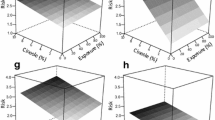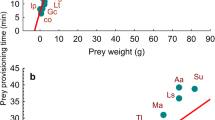Summary
Optimization models lead one to predict that the energy invested in competitive interference with feeding should increase as the quality of the contested food increases. This prediction was tested in a study of feeding interruptions involving juvenile yellow baboons (Papio cynocephalus) in Amboseli National Park, Kenya. For each of the 50 foods eaten by these young primates, 6 measures of food quality (energy content, protein content, yield, yield rate, processing value, and dispersion) and one measure of the spatial deployment of baboons (number of neighbors) were examined for correlations with 4 measures of the frequency and intensity of interruptions (interruption rate, probability of unsuccessful attempts, probability of appropriation, and probability of agonistic behavior). Disperson of food and the proximity of neighboring baboons had little or no effect on the frequency or intensity of interruptions. Food quality had negligible effects on the probabilities of appropriation and agonistic behavior. Yield characteristics were the best predictors of the success of attempted interruptions: attempts were least likely to be successful when processing the food was time-consuming. These results suggest that (1) the interrupter decides whether to interrupt on the basis of increasing its probability of winning the contest and decreasing its cost, and (2) the victim decides whether to resist on the basis of the time that has been and must be invested in harvesting the contested food item.
Similar content being viewed by others
References
Altmann J (1974) Observational study of behaviour: sampling methods. Behaviour 49:227–267
Altmann J, Altmann S, Hausfater G, McCuskey S (1977) Life history of yellow baboons: physical development, reproductive parameters, and infant mortality. Primates 18:315–330
Altmann S, Altmann J (1970) Baboon ecology: African field research. Univ of Chicago Press, Chicago
Altmann SA, Post DG, Klein DF (1987) Nutrients and toxins of plants in Amboseli, Kenya. Afr I Ecol (in press)
Berkson G, Schusterman RJ (1964) Reciprocal food sharing of gibbons. Primates 5:1–10
Bertram BCR (1978) Living in groups. In: Krebs JR, Davies NB (eds) Behavioural ecology: an evolutionary approach. Blackwell, Oxford, pp 64–96
Cheney DL (1977) The acquisition of rank and the development of reciprocal alliances among free-ranging immature baboons. Behav Ecol Sociobiol 2:303–318
Dittus WPJ (1977) The social regulation of population density and age-sex distribution in the toque monkey. Behaviour 63:281–332
Dittus WPJ (1979) The evolution of behaviors regulating density and age-specific sex ratios in a primate population. Behaviour 69:265–302
Enquist M, Plane E, Röed J (1985) Aggressive communication in fulmars (Fulmarus glacialis) about food. Anim Behav 33:1007–1020
Ewald PW (1985) Influence of asymmetries in resource quality and age on aggression and dominance in black-chinned hummingbirds. Anim Behav 33:705–719
Furuichi T (1983) Interindividual distance and influence of dominance on feeding in a natural Japanese macaque troop. Primates 24:445–455
Goss-Custard JD, Clarke RT, dit Durell SEAleV (1984) Rates of food intake and aggression of oystercatchers Haematopus ostralegus on the most and least preferred mussel Mytilus edulis beds of the Exe Estuary. J Anim Ecol 53:233–245
Hamilton WJ III, Buskirk RE, Buskirk WH (1978) Omnivory and utilization of food resources by chacma baboons, Papio ursinus. Am Nat 112:911–924
Harper DGC (1982) Competitive foraging in Mallards: “ideal free” ducks. Anim Behav 30:575–584
Hausfater G (1975) Dominance and reproduction in baboons: a quantitative analysis. Contr Primatol 7:1–150
Janson C (1985) Aggressive competition and individual food consumption in wild brown capuchin monkeys (Cebus apella). Behav Ecol Sociobiol 18:125–138
Jones CB (1983) Social organization of captive black howler monkeys (Alouatta caraya): “social competition” and the use of non-damaging behavior. Primates 24:25–39
Maynard Smith J (1982) Evolution and the theory of games. Cambridge Univ Press, Cambridge
Maynard Smith J, Riechert SE (1984) A conflicting tendency model of spider agonistic behavour: hybrid-pure population line comparisons. Anim Behav 32:564–578
Monaghan P, Metcalfe NB (1985) Group foraging in wild brown hares: effects of resource distribution and social status. Anim Behav 33:993–999
Parker GA (1974) Assessment strategy and the evolution of fighting behaviour. J Theor Biol 47:223–243
Post DG (1982) Feeding behavior of yellow baboons (Papio cynocephalus) in the Amboseli National Park, Kenya. Int J Primatol 3:403–430
Post DG, Hausfater G, McCuskey SA (1980) Feeding behavior of yellow baboons (Papio cynocephalus): relationship to age, gender and dominance rank. Folia Primatol 34:170–195
Robinson SK (1985) Fighting and assessment in the yellow-rumped cacique (Cacicus cela). Behav Ecol Sociobiol 18:39–44
Rubenstein DI (1978) On predation, competition, and the advantages of group living. In: Bateson PPG, Klopfer PH (eds) Perspectives in ethology. Plenum Press, New York, pp 205–231
Sigg H, Falett J (1985) Experiments on respect of possession and property in hamadryas baboons (Papio hamadryas). Anim Behav 33:978–984
Southwick CH (1967) An experimental study of intragroup agonistic behavior in rhesus monkeys (Macaca mulatta). Behaviour 28:182–209
Vines G (1980) Spatial consequences of aggressive behaviour in flocks of oystercatchers, Haematopus ostralegus L. Anim Behav 28:1175–1183
Walters J (1980) Interventions and the development of dominance relationships in female baboons. Folia Primatol 34:61–89
Wasserman FE, Cruikshank WW (1983) The relationship between time of feeding and aggression in a group of captive hamadryas baboons. Primates 24:432–435
Western D, van Praet C (1973) Cyclical changes in the habitat and climate of an African ecosystem. Nature (Lond) 241:104–106
Whitten PL (1983) Diet and dominance among female vervet monkeys (Cercopithecus aethiops). Am J Primatol 5:139–159
Wilson EO (1975) Sociobiology: the new synthesis. Belknap Press, Cambridge, Mass
Wrangham RW (1980) An ecological model of female-bonded primate groups. Behaviour 75:262–300
Author information
Authors and Affiliations
Rights and permissions
About this article
Cite this article
Shopland, J.M. Food quality, spatial deployment, and the intensity of feeding interference in yellow baboons (Papio cynocephalus). Behav Ecol Sociobiol 21, 149–156 (1987). https://doi.org/10.1007/BF00303204
Received:
Accepted:
Issue Date:
DOI: https://doi.org/10.1007/BF00303204




